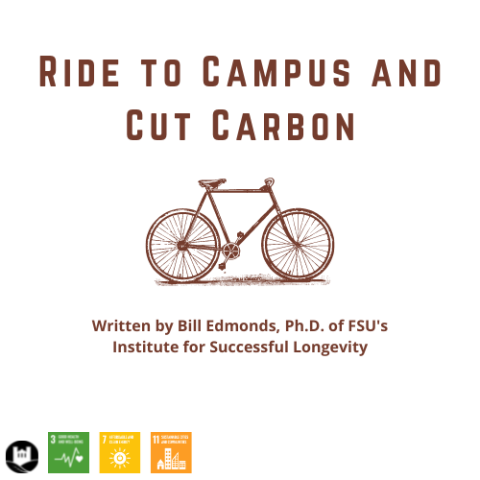Ride to Campus and Cut Carbon

This blog post was written by Bill Edmonds, Ph.D., who handles communications for FSU’s Institute for Successful Longevity.
How big of an environmental benefit comes from cycling to campus when compared to driving?
The carbon savings may surprise you. Let’s look at my numbers.
I’m a bicycle commuter, riding from Tallahassee’s Killearn Estates neighborhood to my office in the Psychology Department at Florida State University. That’s about 11.5 miles one-way, or a little over 23 miles roundtrip (because my route home is longer than the way in).
In 2022, I rode more than 3,300 miles. Most of those were commuting miles—riding to work instead of driving. A few were other rides with friends or to get more exercise. So, let’s carve out 200 “fun” miles.
That leaves 3,100 commuter miles.
My SUV gets about 17 miles per gallon when I drive to work. So, if I had driven to work for all of those miles rather than biked, I would have burned 182 gallons of gasoline.
Every gallon of gasoline burned creates about 8,887 grams of CO2. That’s 19.5 pounds of carbon dioxide—a surprisingly big number, since a gallon of gas itself weighs about 6 pounds.
Burning 182 gallons would have put 1,617,434 grams of CO2—3,566 pounds of carbon dioxide—into the atmosphere.
That’s almost 2 tons of carbon dioxide I did not introduce into our world by choosing to ride my bike to work.
There are, of course, other bad tailpipe gases as well. My bike spewed none of those.
Want to make a difference in the fight against global warming? Ride your bike.

Bicycle commuting provides other benefits, too:
- Bicycle parking is easy and abundant. Riding your bike to FSU takes pressure off the campus parking lots and gets you out of the parking-spot hunt.
- Riding instead of driving removes your car from the traffic stream. Every car makes a difference. A bicycle rider has little impact on street wear and tear. Not so much with cars, trucks, and SUVs.
- Riding to work is great exercise, twice a day.
- Riding to work is less stressful than driving. It takes you out of the lane-jumping, tail-gating Darwinian competition that drivers engage in.
- Riding to work clears your head—you arrive on campus energized and feeling great.
What are the keys to a happy commute?
- A good route is essential. On a bike, you don’t have to take the usual path that drivers follow. Build a low-stress route and enjoy the ride.
- Basic skills are good. Nothing tricky, just learn when to share the road and when to control the lane (when there is not room enough to share). Look over your shoulder before moving about. Signal your intentions. Simple stuff.
- A comfortable bike is needed. Almost any bike will do. Air up the tires, adjust the seat to your liking and…ride.
Want to make a difference? Ride your bike to campus—the carbon numbers don’t lie. It is good for our environment, good for you, and good for FSU.

